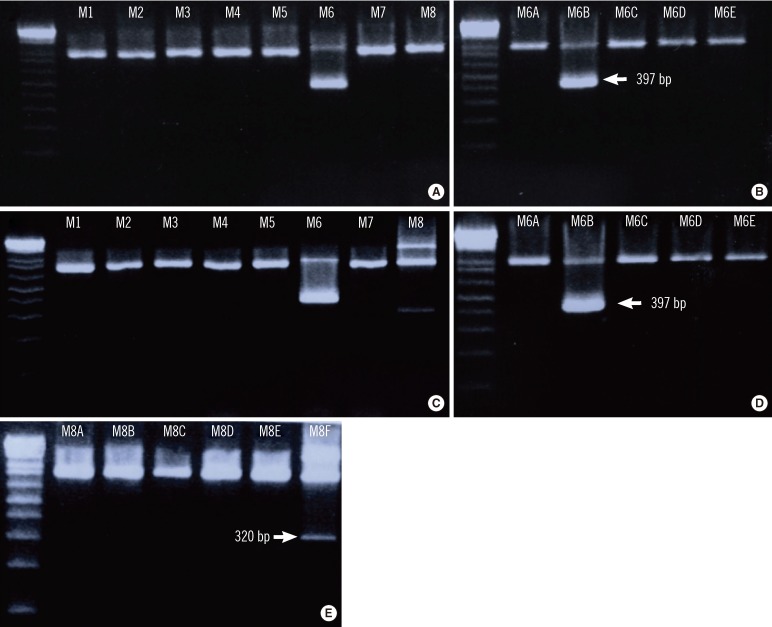Ann Lab Med.
2013 Jan;33(1):80-83. 10.3343/alm.2013.33.1.80.
A Case with Coexistence of Major and Minor BCR/ABL Fusion Transcript at Lymphoblastic Crisis of Chronic Myelogenous Leukemia in Patients with Major BCR/ABL Positivity during Chronic Phase
- Affiliations
-
- 1Department of Laboratory Medicine, University of Ulsan College of Medicine and Asan Medical Center, Seoul, Korea. hschi@amc.seoul.kr
- 2Department of Pediatrics, University of Ulsan College of Medicine and Asan Medical Center, Seoul, Korea.
- KMID: 1781303
- DOI: http://doi.org/10.3343/alm.2013.33.1.80
Abstract
- No abstract available.
MeSH Terms
-
Adolescent
Antineoplastic Agents/therapeutic use
Benzamides/therapeutic use
Chromosome Deletion
Chromosomes, Human, Pair 7
Drug Resistance, Neoplasm
Fusion Proteins, bcr-abl/genetics/*metabolism
Humans
Immunophenotyping
Karyotyping
Leukemia, Myelogenous, Chronic, BCR-ABL Positive/*diagnosis/drug therapy/metabolism
Male
Piperazines/therapeutic use
Pyrimidines/therapeutic use
Real-Time Polymerase Chain Reaction
Antineoplastic Agents
Benzamides
Fusion Proteins, bcr-abl
Piperazines
Pyrimidines
Figure
Reference
-
1. Oh SH, Park TS, Kim HR, Lee JY, Kim JH, Shin JH, et al. Chronic myelogenous leukemia showing biphenotypic blast crisis followed by lineage switch to B lymphoblastic leukemia. Leuk Res. 2009; 33:e195–e198. PMID: 19446879.
Article2. Griesshammer M, Heinze B, Hellmann A, Popp C, Anger B, Heil G, et al. Chronic myelogenous leukemia in blast crisis: retrospective analysis of prognostic factors in 90 patients. Ann Hematol. 1996; 73:225–230. PMID: 8959940.
Article3. Griesshammer M, Heinze B, Bangerter M, Heimpel H, Fliedner TM. Karyotype abnormalities and their clinical significance in blast crisis of chronic myeloid leukemia. J Mol Med (Berl). 1997; 75:836–838. PMID: 9428614.
Article4. Kawano N, Okuda S, Yoshida S, Kugimiya H, Ito M, Horikawa N, et al. Successful treatment of lymphoid blastic crisis in chronic myelogenous leukemia with the additional bcr/abl transcript using imatinib-combined chemotherapy and high-dose chemotherapy with allogeneic bone marrow stem cell transplantation. Int J Hematol. 2011; 94:561–566. PMID: 22057509.
Article
- Full Text Links
- Actions
-
Cited
- CITED
-
- Close
- Share
- Similar articles
-
- Analysis of BCR-ABL Fusion Transcripts of Chronic Myeloid Leukemia Patients in Korea
- A Case of Acute Lymphoblastic Leukemia with ider(9)(q10)t(9;22)(q34;q11.2)
- Development of Tyrosine Kinase Inhibitor in Chronic Myeloid Leukemia
- Clinical Resistance to the Tyrosine Kinase Inhibitor Imatinib (STI571) and Detection of BCR-ABL Gene Mutations in Korean Patients with Chronic Myeloid Leukemia
- Progressive De Novo DNA Methylation at the Pa Promotor of the Abl Genein the Bcr-Abl Locus during the Course of Chronic Myelogenous Leukemia



